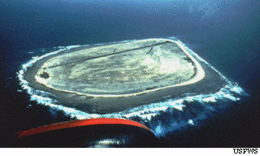Nickname: New Nantucket | |
|---|---|
 U.S. Fish and Wildlife Service aerial view of Baker Island | |
| Geography | |
| Location | Pacific Ocean |
| Coordinates | 0°11′45″N 176°28′45″W / 0.19583°N 176.47917°W |
| Area | 2.1 km2 (0.81 sq mi) |
| Length | 1.81 km (1.125 mi) |
| Width | 1.13 km (0.702 mi) |
| Coastline | 4.8 km (2.98 mi) |
| Highest elevation | 8 m (26 ft) |
| Administration | |
| Status | Unincorporated |
| Demographics | |
| Population | 0 (2000) |
| Additional information | |
| Time zone |
|
| Baker Island National Wildlife Refuge | |
| Designated | 1974 |
| Website | www |
Baker Island, formerly known as New Nantucket,[1] is a small, uninhabited atoll located just north of the Equator in the central Pacific Ocean, approximately 1,920 miles (3,090 kilometres) southwest of Honolulu. Positioned almost halfway between Hawaii and Australia, its closest neighbor is Howland Island, situated 42 mi (68 km) to the north-northwest. Both Baker and Howland Islands have been claimed as territories of the United States since 1857, though the United Kingdom regarded them as part of the British Empire between 1897 and 1936.[2]
Covering an area of 0.81 sq mi (2.1 km2),[3] with 3.0 mi (4.8 km) of coastline,[3] Baker Island experiences an equatorial climate, characterized by average temperatures around 80 °F (27 °C), minimal rainfall, persistent winds, and strong sunlight. The terrain is flat and sandy, surrounded by a narrow, fringing reef. Unlike many atolls, Baker Island lacks a central lagoon, with its highest point being 26 ft (7.9 m) above sea level.[3][4]
Today, Baker Island is part of the Baker Island National Wildlife Refuge, an unincorporated and unorganized territory of the U.S. The island is managed by the U.S. Fish and Wildlife Service and is visited annually for conservation purposes. Statistically, Baker Island is grouped with the United States Minor Outlying Islands and, along with Howland Island, is among the last places on Earth to experience the New Year, operating in the UTC−12:00 time zone. It is one of the most remote U.S. possessions in the equatorial Pacific.[5]
- ^ Rauzon, Mark J. (2016). Isles of Amnesia: The History, Geography, and Restoration of America's Forgotten Pacific Islands. University of Hawai'i Press, Latitude 20. Page 110. ISBN 9780824846794.
- ^ "Baker, Howland, and Jarvis Islands | Facts & Information | Infoplease". www.infoplease.com. Retrieved September 3, 2024.
- ^ a b c "United States Pacific Island Wildlife Refuges". The World Factbook (2024 ed.). Central Intelligence Agency. Retrieved April 25, 2014. (Archived 2014 edition.)
- ^ "Howland Island | Wildlife, Coral Reefs & Lagoons | Britannica". www.britannica.com. Retrieved September 3, 2024.
- ^ Rauzon, Mark J. (2016). Isles of Amnesia: The History, Geography, and Restoration of America's Forgotten Pacific Islands. University of Hawai'i Press, Latitude 20. Pages 38 and 104. ISBN 9780824846794.
